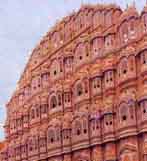|
Rajasthan - Jaipur The Capital
Pink in colour, the Capital city has come to be called the pink city of Rajasthan. Pink has a connotation of Rajput
hospitality, and may also be of the so-called brilliance
of royal romance. It was built by Maharaja Sawai Jai Singh
II in 1727 AD. Encircled by a wall, the city has a grid
system of design done by one Bengali architect, Vidyadhar
Bhattacharya. The planned city has a symmetry in the arrangements
of various structures. It is divided into nine rectangular
sectors called chokris. The streets are wide and the buildings
like shops appear in lines. One can relax in the parks
and the gardens. Palaces have been converted into heritage
hotels.
The City Palace: This complex of palaces is a landmark in Jaipur and well-known tourist attraction. The first structures were constructed by Maharaja Sawai Jai Singh, the founder of Jaipur. The white marble columns and the colourful motifs of the City Palace located in the heart of the city are an illustration of a fusion of Mughal and Indian
architecture. It has a museum which contains Mughal and
Rajput weapons. An art gallery has miniature paintings.
 Hawa Mahal: Hawa in Hindi means wind, and therefore,
Hawa Mahal means 'Palace of Winds'. Built in 1799, it is located in the old city. It is said that the palace was designed to facilitate
womenfolk to watch processions etc on the streets without
being seen. It is a five-storied building.
Hawa Mahal: Hawa in Hindi means wind, and therefore,
Hawa Mahal means 'Palace of Winds'. Built in 1799, it is located in the old city. It is said that the palace was designed to facilitate
womenfolk to watch processions etc on the streets without
being seen. It is a five-storied building.
Jantar Mantar: The instruments like Ram Yantra in this
observatory throw light on the status of Indian astronomy
during the medieval period.
Govind Devji temple: The idol inside this Krishna temple was shifted here from Vrindavan in Mathura, in today's Uttar Pradesh, by Maharaja
Sawai Jai Singh II. It is a well-known temple in the city.
Other sites:- The Statue, built to pay homage to the founder of Jaipur, Sawai Jai Singh; Swargasuli tower;
Island palace or Jal Mahal in Man Sagar lake; the royal
crematorium; Ghat Ki Guni gardens; Nahargarh fort; Amer, erstwhile Kachhwaha Capital; Shila Mata temple in Amer
whose idol was brought from former East Pakistan; Amer
palace. One shouldn't miss the palace and the temple.
Jaigarh has a military station of the medieval
period containing a massive cannon called Jai Ban.
EXCURSIONS
Ramgarh lake (32 km): It is a large artificial lake
and is a picnic spot; Sanganer (12 km on Tonk Road): Has
palaces, Jain temples and popular centres of textile crafts;
Samod palace (40 km); Bairath (85 km on Shahpura-Alwar
Road): The remains of Buddhist temple can be seen here.
There are also constructions of the Mughal period and
even ancient regimes; Abhaneri (125 km, near Bandikui):
Jain temples and a 7th century Hindu temple can be seen
here; Sambhar (95 km): The country's largest inland salt
lake is here. The Devyani tank is located here; Madhogarh-Tunga(40 km): The battle with the Marathas was fought here.
HOW TO REACH: Well-connected by air, rail and road with all major towns. Cycle-rickshaw, auto-rickshaw, bus and taxi are the local means of transport.
CLIMATE: Summer temp range, 25 to 45 deg C; winter temp range, 8 to 22 deg C
CLOTHING: Cotton in summer, light woollen in winter
SHOPPING: The exclusive travellers' items include gems, Sanganeri cotton prints, kota sari, brassware and juti footwear. The main shopping
centres are Rajasthali Govt handicrafts shop on MI Road
and Chaupar stalls.
LANGUAGES: Hindi, Rajasthani, English
|